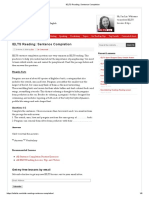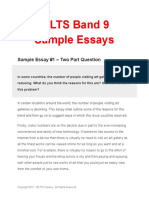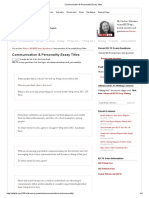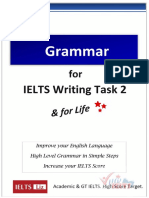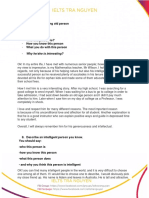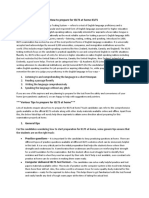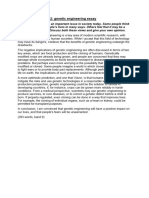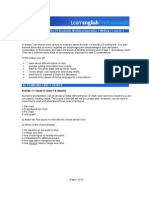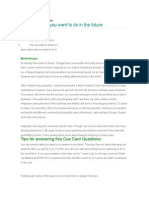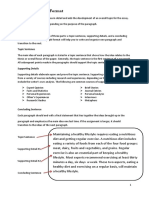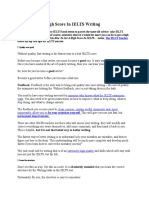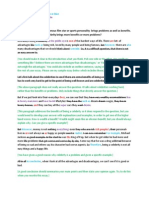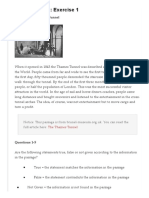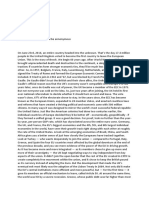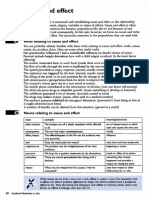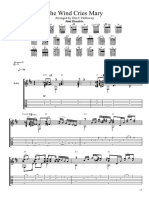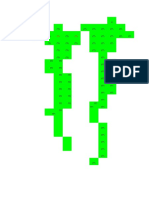0 ratings0% found this document useful (0 votes) 421 views2 pagesGraphs Obesity - Vocabulary For IELTS Advanced
Copyright
© © All Rights Reserved
We take content rights seriously. If you suspect this is your content,
claim it here.
Available Formats
Download as PDF or read online on Scribd
ARM ae teverss
AV.V
iT] In Writing Task 1, you may be asked to describe facts or figures presented in a chart or graph.
Describe the following bar chart, Make sure you include an introduction, overview and all the
most noticeable trends. You will have to include all the age groups, all the weight categories, the
percentage figures and main trends.
Weight assessment of inhabitants of Newtown 2010
40-49
Age range
50-59
EE] Now look 2t the bar chart for 1950 and think about how
you might describe it.
Weight assessment of inhabitants of
Newtown 1950
100%
wie underweight
60% obese
40% overweight
a ideal
0% "
PP oe
Ago range
120
mobese
overweight
ideal
underweight
0-69
Be carefull of the following common
errors when describing mumbers.
‘amount and number: amount is used
with uncountable nouns; number is
used with countable nouns, e.g. The
chart shaws the amount of traffie in
the city between 1950 and 2000. NOT
umber of traffic
per cent and percentage: per cent
is always used with a number:
percentage is used on its own without
a number, e.g. The chart shows the
percentage of females enrolled in tertiary
education, NOT the percent of females,
According to the graph, five per cent ofall
government spending was on education
NOT fivepereentage�IELTS Writing 2 3
[EXE] in Weiting Task 1, you may be asked to describe one chart or 7g
compare two. Read the modal answer below, which refers to
the charts in 1.1 and 1.2. Choose the correct alternative for
V nor
Be careful of the following common
each gap. emmors when describing changes in
‘The charts provide an analysis of the weight issues among the numbers.
tesiclents of the town of Newtown in 1950 and in 2010. ‘There was an inerease of 20% between
1950 and 2010. NOT arrinerease in 20%
In 1950, the youngest age group had the fewest ‘number / : a
amount of weight issues, with mote than 70% of 20-29-year- Feet a Re arene eae;
Olds being assessed as having a healthy weight. In the same year, Seer,
‘excess weight was only a significant problem among 40-49-year-oles, 20-30% of whom were clasified
a5 either overweight or obese. In fact, being underweight was.a more significant problem affecting more
than twenty “per cent / percentage of each age group, and the elderly in particular, with 40% of the over
60s being classified as underweight.
In stark contrast to this. Yor / in 2010, being underweight was only a problem among 20-29-year okds,
with 20% obtaining this diagnosis, and che number of underweight elderly people had fallen ‘by / to 10%.
‘The charts clearly show that, in modern times, obesity poses a considerable problem from the age of 30
upwards. In fact, there was a steadily / steady increase in this problem in almost every age group over 29
Until the age oF 60, when the vast majority are considered to have an unhealthy weight. Itis important to
rote that, by the age of 60, less than 50% of each age group was considered to have a perfect weight by
the year 2010. This isa fallin / of 10% compared ‘of /to the same age group in 1950.
‘When *compared I comparing the two years its clear that there has been a significant increase
“in / of the number of obese people in Newtown, and there was a general drop "of/ in the number of
underweight people between 1950 and 2010.
=n
Ed ©0 00 60 a
You may need to describe how a process
works using a diagram, or describe amapor — -<
plan. Study the following question. Sy dt fl a
The plans show proposed changes toa eb. exhibition space eee
university art gallery. S || ottice | qe
Summarise the information by selecting 2 lf
and reporting the main features, and make
comparisons where relevant.
| The words in the box can be used to describe
Ba oo 00 oo of
Sg ”
the diagrams in2.1. Decide ifthey mean now
orefeer. % J exhibition space
ye ees anti Ee
education
centre
ES cen stacey le)
aeRO Te ee
rar




